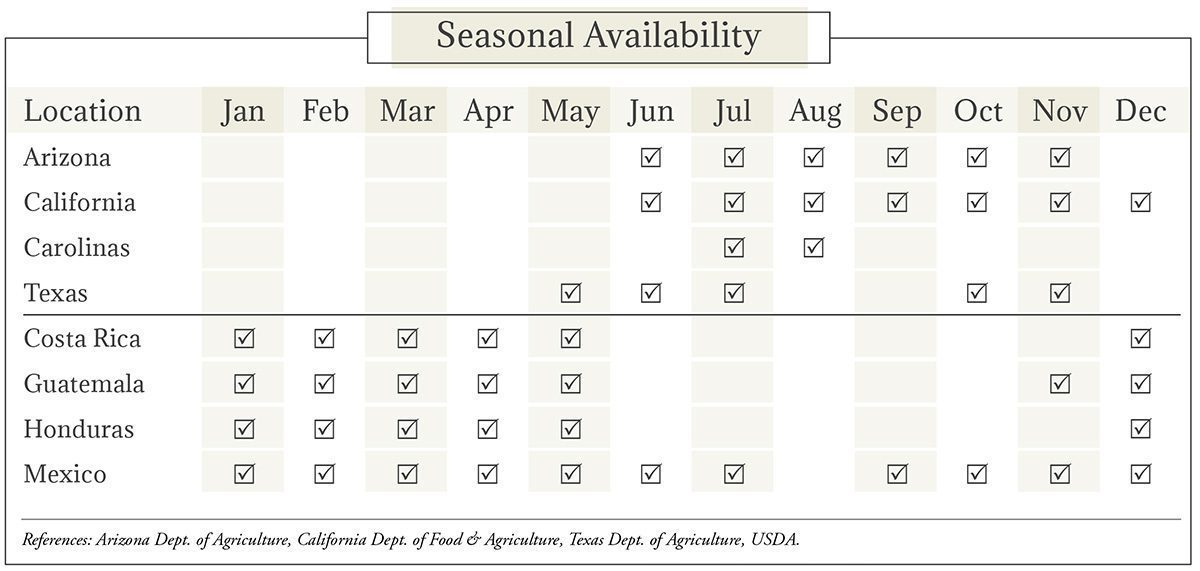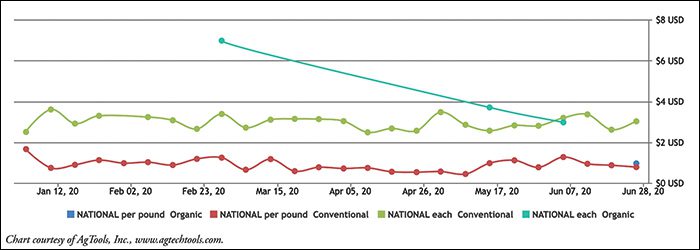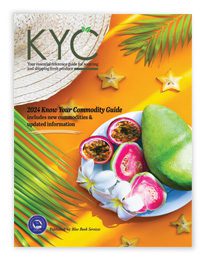Honeydew Melon Market Summary


Image: Izf/Shutterstock.com
Honeydew Melon Market Overview
The precise origin of honeydew melon (Cucumis melo var. inodorous) is unclear. While some believe the melons originated in Central America, others point to the Middle East, including Persia, or parts of Asia, such as India, as the first to cultivate the fruit. Another faction credits West Africa as the birthplace of the melon, more than 4,000 years ago. Just as it is prized today for its sweetness, Egyptians regarded honeydew as a sacred fruit. Tomb hieroglyphics, dating back to 2,400 B.C., show detailed instructions on the melon’s possible uses in the afterlife. In more recent history, honeydew made its way to Europe in the 15th century and has been a popular crop ever since. In America, seeds were brought by Columbus, although indigenous peoples were already cultivating the fruit in temperate regions throughout North America. Spanish explorers began growing the melons in California, where it became a mainstay at missions. The Golden State has since become the top producer of melons, including honeydew, in the United States. There are substantial plantings in both spring and fall to keep up with demand. The Imperial and San Joaquin valleys are top growing areas, with other producers scattered within the state. Though there is a tiny town called Honeydew in Humboldt County, in Northern California, it is not known for producing the fruit. A member of the cucurbit or gourd family, honeydew is related to squash, cucumbers, and of course, other melons. Sometimes known as “temptation” melons (there’s even a hybrid variety with this name), a ripe honeydew is lauded as the sweetest type of melon. Nevertheless, it is ranked as the nation’s third most popular melon, behind watermelon and cantaloupe. The flavor and its healthy attributes (Vitamin C, potassium, fiber, and more) may explain honeydew’s ongoing popularity in the fruit universe: per capita consumption in the United States has climbed steadily since the 1960s.
Types & Varieties of Honeydew Melon
Honeydew plants are similar to cantaloupe (a type of muskmelon), but with more lobing on the leaves. The names are often used interchangeably, but the melons themselves are quite different. This is true not only from a visual standpoint but in aroma (honeydew has no outward odor, while cantaloupe and muskmelon do), flesh, and flavoring. Honeydews are slightly oval to round with a smooth, tough rind with no ribbing that begins very light green with soft hairs and matures to a smooth white or yellow color (depending on type) as it ripens. Flesh is generally green (though there are hybrids with other colors, including orange like cantaloupe) and relatively firm. Cantaloupe, on the other hand, has a darker skin with distinctive netting, and softer orange flesh. Both melons have dense, velvety, juicy flesh (up to 90% water content), and provide plenty of vitamins, minerals, and fiber. Common honeydew varieties include Dewlightful, Earlidew, Honeybrew, Jade Delight, New Moon, Summer Dew, and TAM Dew. Hybrids with orange flesh, unlike traditional honeydew, will have a slight aroma and continue to ripen after picking. Varieties include Orange Blossom, Orange Delight, Orange Dew.

Cultivation of Honeydew Melon
Honeydew melons are a warm-season crop, preferring semiarid regions with growing temperatures ranging from 85 to 90°F for optimal growth. Plants tend to do poorly in chilly or overly humid conditions. Planting can be direct-seed or transplant. Seed plantings must be timed one to two weeks after the last frost as ideal ambient temperatures range from 60 to 95°F. Sandy, light soils that warm quickly in springtime are optimal. Soil should be high in organic matter, with a pH from 6.0 to 7.5 (depending on area), and have the ability to drain excess moisture, especially if direct sunlight is lacking. Ideal temperatures range from 70 to 90F° for germination. Direct-seed honeydew should be planted about a half-inch deep in either rows or hills (if needed for drainage). Rows should be spaced 5 feet apart with seeds spaced at 1 seed per foot within rows. Hills can be spaced 4 to 6 feet apart with 6 seeds per hill. Trellising will allow for closer spacing. As the plants grow, they should be thinned to 2 to 3 plants per hill. In areas prone to windy conditions, windbreaks will prevent damage to vines and developing fruit. Vines will grow to between 1 to 1.5 feet in length with a spread from 3 to 12 feet, accompanied by coarse, green foliage. Vines may trail across the ground or climb, and will produce both male and female flowers. Mulching will help maintain moisture, which is crucial until pollination. Bees are required for pollination for proper fruit set. Each vine typically yields 3 to 4 melons. Honeydew do not slip from the vine and must be harvested by maturity, not size. The fruit will also not ripen further after harvest (except, as noted, with some of the orange-flesh muskmelon hybrids). Maturity is determined by size and color, and the emergence of protective waxiness on the outer skin. Maturity is classified as Mature/Unripe, Mature/Ripening, or Ripe; the second designation, Mature/Ripening, is preferred for commercial sales. Cooling after harvest is highly recommended, commonly with forced air. Postharvest treatment typically includes ethylene for 18 to 24 hours to ripen mature melons more uniformly.Pests & Diseases Affecting Honeydew Melon
Striped or spotted cucumber beetles can damage leaves, stems, fruit, and vines. Beetles lay eggs in early summer and hatched larvae consume roots leading to weakened plants. They can also damage developing rinds, making the fruit unmarketable. Cucumber beetles also play a role in spreading bacterial wilt (see below). Aphids typically feed by sucking fluid from plant tissues, leaving behind the sticky waste actually called honeydew that attracts ants and flies, creating more problems. Aphids can be hard to control because of rapid reproduction rates and their tendency to avoid pesticide applications by residing on the underside of leaves. Yellow or reddish mites also suck nutrients from leaves, leading to a crusty and discolored appearance. Additional pests of concern include flea beetles, maggots, root-knot nematodes in the soil, squash bugs, and squash vine borers. Bacterial wilt severely weakens vines and is often followed by plant death. Given the bacteria is typically carried by cucumber beetles, it can best be prevented by controlling beetle populations before they damage plants. Powdery mildew covers leaves and stems with a characteristic white coating, often leading to stunted fruit growth and development. Lesions on leaves may also be a sign of downy mildew, especially if they expand and become brownish in hue, giving affected leaves with a ‘scorched’ appearance. Once established, the disease is hard to control; planting resistant cultivars (such as the TAM Dew, which is resistant to both downy and powdery mildew) is the best defense, though avoiding overhead irrigation and damp conditions can help as well. Anthracnose typically develops during cool, rainy periods with yellow or water-soaked marks on leaves, expanding into a ‘shot hole’ appearance. Crop rotation and removal of old vines can help prevent the disease from overwintering. Other diseases that affect honeydew include blight, cucumber mosaic virus, damping off, fungal leaf spot, fusarium wilt, various types of rot, and scab.Storage & Packaging of Honeydew Melon
Ideal storage conditions will have temperatures between 45 and 50°F and 85 to 90% relative humidity. Honeydew can be stored for up to about 3 weeks at 45°F. Extended exposure to cooler temperatures can cause chilling injury to the fruit. Honeydew produces ethylene and should not be stored with fruits or vegetables sensitive to the gas. Similarly, fresh-cut honeydew will absorb odors quickly. References: California Dept. of Food & Agriculture, Clemson Cooperative Extension, Cornell University, Iowa State University, University of Arkansas Cooperative Extension Service, University of Arizona, University of California, Davis, University of Florida/IFAS Extension, University of Illinois Extension, University of Oregon Dept. of Horticulture, USDA.
Grades & Good Arrival of Honeydew Melon
Honeydew can be classified as U.S. No. 1, U.S. Commercial, and U.S. No. 2. For U.S. No. 1 quality fruit will be mature, firm, well-formed, and free from decay as well as damage from pests, diseases, dirt, aphis stain, rust spots, bruises, cracks, broken skin, sunscald, sunburn, hail, and moisture. For U.S. Commercial, honeydew must meet the requirements of U.S. No. 1 except for the increased tolerances for defects (see Good Arrival chart below). For U.S. No. 2, melons must be mature, firm, fairly well-formed, free from decay, and free from serious damage by any cause.Generally speaking, the percentage of defects shown on a timely government inspection certificate should not exceed the percentage of allowable defects, provided: (1) transportation conditions were normal; (2) the USDA or CFIA inspection was timely; and (3) the entire lot was inspected.
| U.S. Grade Standards | Days Since Shipment | % of Defects Allowed | Optimum Transit Temp. (°F) |
| 10-5-1 | 5 4 3 2 1 | 15-8-3 14-8-3 13-7-2 11-6-1 10-5-1 | 45-50° |
Honeydew Retail Pricing: Conventional & Organic



